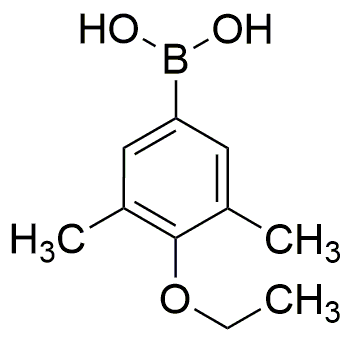4-Ethoxy-3,5-dimethylphenylboronic acid is widely utilized in research focused on:
- Organic Synthesis: This compound serves as a versatile building block in the synthesis of complex organic molecules, particularly in the development of pharmaceuticals and agrochemicals.
- Cross-Coupling Reactions: It is commonly used in Suzuki-Miyaura coupling reactions, allowing for the formation of carbon-carbon bonds, which is essential in creating diverse chemical libraries for drug discovery.
- Bioconjugation: The boronic acid functionality enables selective binding to diols, making it useful in bioconjugation processes for developing targeted drug delivery systems.
- Sensor Development: This compound can be employed in the fabrication of chemical sensors, particularly for detecting glucose levels, benefiting the medical diagnostics industry.
- Material Science: It is also applied in the development of advanced materials, such as polymers that exhibit unique properties, enhancing performance in various industrial applications.
Informations générales
Propriétés
Sécurité et réglementation
Applications
4-Ethoxy-3,5-dimethylphenylboronic acid is widely utilized in research focused on:
- Organic Synthesis: This compound serves as a versatile building block in the synthesis of complex organic molecules, particularly in the development of pharmaceuticals and agrochemicals.
- Cross-Coupling Reactions: It is commonly used in Suzuki-Miyaura coupling reactions, allowing for the formation of carbon-carbon bonds, which is essential in creating diverse chemical libraries for drug discovery.
- Bioconjugation: The boronic acid functionality enables selective binding to diols, making it useful in bioconjugation processes for developing targeted drug delivery systems.
- Sensor Development: This compound can be employed in the fabrication of chemical sensors, particularly for detecting glucose levels, benefiting the medical diagnostics industry.
- Material Science: It is also applied in the development of advanced materials, such as polymers that exhibit unique properties, enhancing performance in various industrial applications.
Documents
Fiches de données de sécurité (FDS)
La FDS fournit des informations de sécurité complètes sur la manipulation, le stockage et l’élimination du produit.
Spécifications du produit (PS)
Le PS fournit une description complète des propriétés du produit, notamment sa composition chimique, son état physique, sa pureté et les exigences de stockage. Il détaille également les plages de qualité acceptables et les applications prévues du produit.
Certificats d'analyse (COA)
Recherchez des certificats d'analyse (COA) en saisissant le numéro de lot du produit. Les numéros de lot et de lot se trouvent sur l'étiquette d'un produit, après les mots « Lot » ou « Lot de fabrication ».
Numéro de catalogue
Numéro de lot/série
Certificats d'origine (COO)
Ce certificat d'exploitation confirme le pays dans lequel le produit a été fabriqué, et détaille également les matériaux et composants utilisés et s'il est issu de sources naturelles, synthétiques ou autres sources spécifiques. Ce certificat peut être requis pour les douanes, le commerce et la conformité réglementaire.
Numéro de catalogue
Numéro de lot/série
Fiches de données de sécurité (FDS)
La FDS fournit des informations de sécurité complètes sur la manipulation, le stockage et l’élimination du produit.
DownloadSpécifications du produit (PS)
Le PS fournit une description complète des propriétés du produit, notamment sa composition chimique, son état physique, sa pureté et les exigences de stockage. Il détaille également les plages de qualité acceptables et les applications prévues du produit.
DownloadCertificats d'analyse (COA)
Recherchez des certificats d'analyse (COA) en saisissant le numéro de lot du produit. Les numéros de lot et de lot se trouvent sur l'étiquette d'un produit, après les mots « Lot » ou « Lot de fabrication ».
Numéro de catalogue
Numéro de lot/série
Certificats d'origine (COO)
Ce certificat d'exploitation confirme le pays dans lequel le produit a été fabriqué, et détaille également les matériaux et composants utilisés et s'il est issu de sources naturelles, synthétiques ou autres sources spécifiques. Ce certificat peut être requis pour les douanes, le commerce et la conformité réglementaire.


